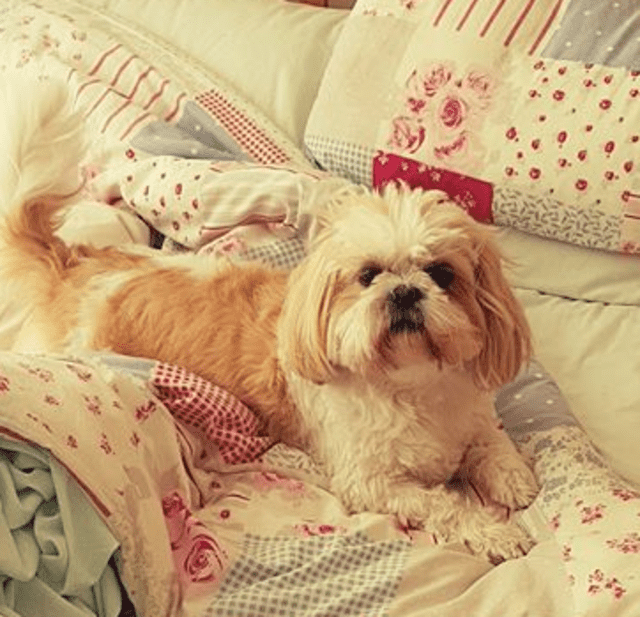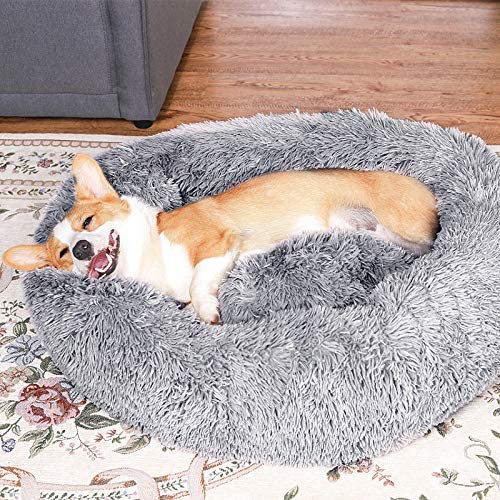Dogs are known for being loyal and loving companions, but they can also be a lot of work when it comes to training them. One common issue many pet owners face is getting their pup to sleep in its own dog bed instead of on the furniture. This can be a problem if you’re trying to keep your dog off the couch or out of your bed! In this blog post, we will discuss tips that can help you train your dog to sleep in its own bed.
By following these simple steps, you’ll have a happy and well-rested pup by your side!

Why you shouldn’t let your dog sleep in your bed
There are some good reasons you shouldn’t let your dog sleep in your bed.
First, getting a good night’s sleep is hard when your dog is in bed. If the dog jumps on you in the middle of the night or takes up too much space, it will prevent you from getting a good night’s rest.
Additionally, letting your dog sleep in your bed can reinforce bad behavior. If you allow your dog to sleep in your bed, he might start to think that it’s okay to jump on the bed or get on furniture, even when you don’t want him to.
Dogs tend to shed a lot of furs, and all that dander can be a major trigger for allergies. Sleeping in his own bed will help to keep those allergens out of your bedding.
Fleas, ticks, and other intestinal parasites often hitch rides on dogs. People who sleep with their dogs expose themselves to these pests and the diseases they carry. Children, senior citizens, and those with weak immune systems are most at risk for infection.
Benefits of a dog bed
There are several benefits of using a dog bed. First, a dog bed can provide insulation for your pet, keeping them warm in the winter and cool in the summer.
Second, a dog bed can help to protect your pet’s joints by providing support and cushioning.
Third, a dog bed can help to reduce stress and anxiety levels by creating a safe and familiar space for your pet.
Fourth, a dog bed can help to protect your floors and furniture from wear and tear.
In addition, a dog bed can also be used as a training tool, helping to teach your pet to stay off the furniture.
In the summer, dogs prefer to sleep on the floor to cool off. It’s typical behavior that has nothing to do with their bed.

How to train your dog to sleep in its own bed?
Introduce the dog bed to your pet gradually.
Start by placing it in the room where your dog sleeps, but don’t force him to use it. Let him sniff it and explore it at his own pace. Once he seems comfortable, you can start encouraging him to lie down in it. You may need to be persistent, but eventually, he should get the idea. Another thing you can do is make the bed extra inviting. Place some of your dog’s favorite toys or blankets in the bed, or give him a treat when he goes into it.
Place the bed in an area where the dog spends a lot of time.
Dogs are creatures of habit, so it can help to place the bed in an area where he already spends a lot of time. For example, if he likes to nap in the living room, put the bed there. That way, he’ll be more likely to use it when sleepy.
Once your dog is used to the bed, you can start creating a sleep routine. For example, if you always give him a treat when he goes into bed, he’ll start associating that behavior with getting sleepy. You can also try putting him in his bed at the same time every night.

Invest in a comfortable dog bed
Buying a comfortable dog bed will provide your pup with the perfect sleeping conditions. Make sure the bed has enough room for a canine to stretch out. Remember your pet sleeps between 12 to 14 hours per hour, which makes an effective pet sleeping arrangement vitally necessary. Your pups have many choices, from memory foam dog beds to waterproof dog beds. For older or arthritic dogs, an orthopedic dog bed is the best solution. These beds have memory foam that contours to your pup’s body and supports pressure points.
An arthritic dog also benefits from an elevated dog bed. These dog beds allow a pet to easily get in and out of bed and provide a comfortable resting place.
When buying dog beds, you really do get what you pay for.
Read more of our dog bed reviews to get the best one for your needs.
Teach your dog basic obedience commands
One of the easiest ways to get your dog to sleep in his own bed is to start with basic obedience commands. Dogs are very responsive to commands when they are puppies, so this is the best time to start teaching them. Make sure that your dog’s bed is in a comfortable spot in your home and that he has plenty of space to sleep in.
Begin by teaching your dog the “down” command. Once he understands this, you can move on to the “stay” command.
After your dog has learned these two commands, you may start training him to sleep in his own bed.
You can teach your dog to perform virtually any bed command you want, including “go to bed.”
Start by putting his bed in the spot where you want him to sleep, and then have him lie down and stay there. If he gets up, move his bed a few inches closer to you and have him lie down again.
Once your dog associates his new bed with the commands “down” and “stay,” he should be able to sleep in it without any problems.
Crate training is vital.
If your dog is having trouble sleeping in his own bed, crate training may be necessary. Crate training is a process of teaching your dog to associate his crate with positive things, such as food and toys.
To start, put his bed in the crate and give him a treat when he goes into it. Once he is comfortable with the crate, you may start closing the door for short periods of time.
Crate training can be difficult, but it is one of the best ways to get your dog to sleep in his own bed.
Be patient and consistent.

Reward your pet when he or she chooses to sleep in the bed.
It’s important to praise your dog when he or she makes the choice to sleep in the new bed. This will help to reinforce the behavior and make it more likely that your dog will continue doing it. You can give your pet a treat, pet him, or simply tell him what a good boy or girl he is! Positive reinforcement is a powerful tool, so be sure to use it when training your dog to sleep in his own bed.
Don’t force the dog to sleep in the bed if he or she doesn’t want to.
If your dog seems resistant to the idea of sleeping in the bed, don’t force him. It’s important to make the experience positive and relaxed, or else your dog may become anxious and stressed. Just keep introducing the bed, and eventually, he should come around.
Be patient and consistent with training.
It may take a while for your pet to get used to sleeping in a bed, but if you’re patient and consistent with the training, he should eventually get there. Just remember to make it a positive experience for both of you; soon enough, your dog will snooze away in his own bed for a good night’s sleep!

Is it good for dogs to sleep in their own bed?
Dogs are typically considered part of the family, and many dog owners allow their furry friends to sleep in the bed with them. However, there are benefits to having your dog sleep in a dog bed instead.
For one thing, it can help to keep your bed clean and free of dog hair. It can also give your dog a sense of security and a sense of ownership over their own space. Additionally, if your dog is prone to anxiety or separation anxiety, sleeping in their own bed can help them feel more relaxed and comfortable.
Having a designated space for your dog to sleep can help them to feel more comfortable when they are away from you.
Additionally, if your dog is crate trained, having a bed in their crate can make it feel more like a home and less like a jail.
In general, giving your dog their own bed can make them feel more comfortable and secure, which can lead to a happier and healthier pet.
Why won’t my dog sleep in his own bed?
There are a few possible reasons why your dog may not be sleeping in his own bed. It could be that the bed is not comfortable enough or that it is located in a place that is too loud or too bright.
Alternatively, your dog may simply be used to sleeping with you and enjoying the extra warmth and security you provide. Or maybe, trying to assert dominance over you by claiming your bed as his own.
If you think the bed is the problem, you can try getting a new one that is more comfortable and inviting. You can also try moving the bed to a different location, such as a quiet corner of the room.
Try making his bed more inviting by adding a cozy blanket or some favourite toys. You can also try rewarding him for sleeping in his bed with treats or praise.
With a little patience and effort, you can help your dog learn to love his own bed.
How do I train my new puppy to sleep in his bed?
Training a new puppy to sleep in his bed can be challenging, but you can do a few things to make the process easier.
First, keep the bed in a quiet, out-of-the-way place where the puppy can feel relaxed and comfortable.
Secondly, make sure the bed is comfortable and inviting by adding soft blankets or towels.
Third, create a nightly routine for the puppy, including going to his bed for a final ‘goodnight’ snuggle.
Fourth, give the puppy plenty of positive reinforcement when he does sleep in his bed, with treats or verbal praise.
Finally, be patient and consistent with your training; eventually, the puppy will learn to sleep in his bed.

FAQs
What to look for in a dog bed?
When it comes time to buy a new dog bed, it’s important to know what to look for.
The first thing to consider is the size of your dog. You’ll want to ensure that the right dog bed is big enough for them to stretch out and move around. Otherwise, they’ll be uncomfortable and might not use it at all.
Another thing to consider is whether your dog has any health issues. If they’re arthritic or have other mobility issues, you might want to look for a bed with special features like orthopedic support. And if you have more than one dog, you might even want to get separate beds for each of them. That way, everyone will be happy and comfortable.
A memory foam dog bed is a great option for most dogs, as it offers support and comfort.
How can I make my dog bed more comfortable?
Most dogs love to sleep in their beds, but some can be picky about what makes a bed comfortable. If your dog is having trouble sleeping in his bed, you can do a few things to make it more comfortable. First, add a blanket or pillow for extra warmth and padding. You might also want to try using a memory foam mattress topper, which can help to relieve any aches and pains. Additionally, ensure the bed is positioned in a quiet, well-ventilated spot so your dog can relax and get the most out of his slumber. You can create a cozy haven for your furry friend to enjoy with a few simple adjustments.
Conclusion
If you’re having trouble getting your dog sleeping in its own bed, don’t worry – you’re not alone! Here are a few tips that can help:
Make sure you are consistent with your commands. Be patient and keep at it. It may take a while for your dog to get used to the new sleeping arrangement. With patience and persistence, you can get your dog sleeping in their bed in no time.
Also, provide positive reinforcement when your dog does sleep in its bed. Rewards such as treats or praise can go a long way in reinforcing good behavior.
Following these tips can help your dog learn to sleep in his or her own bed without trouble.
Recent Posts
As a dog owner, you want to ensure that you take proper care of your furry companion. A common question that many pet owners have is, "Can I walk my dog 30 minutes after eating?" Understanding the...
Have you ever considered getting an elevated dog bed for your furry friend, but wondered if it's worth the investment? If so, you're not alone. As dog owners, we all want to provide the best care for...

